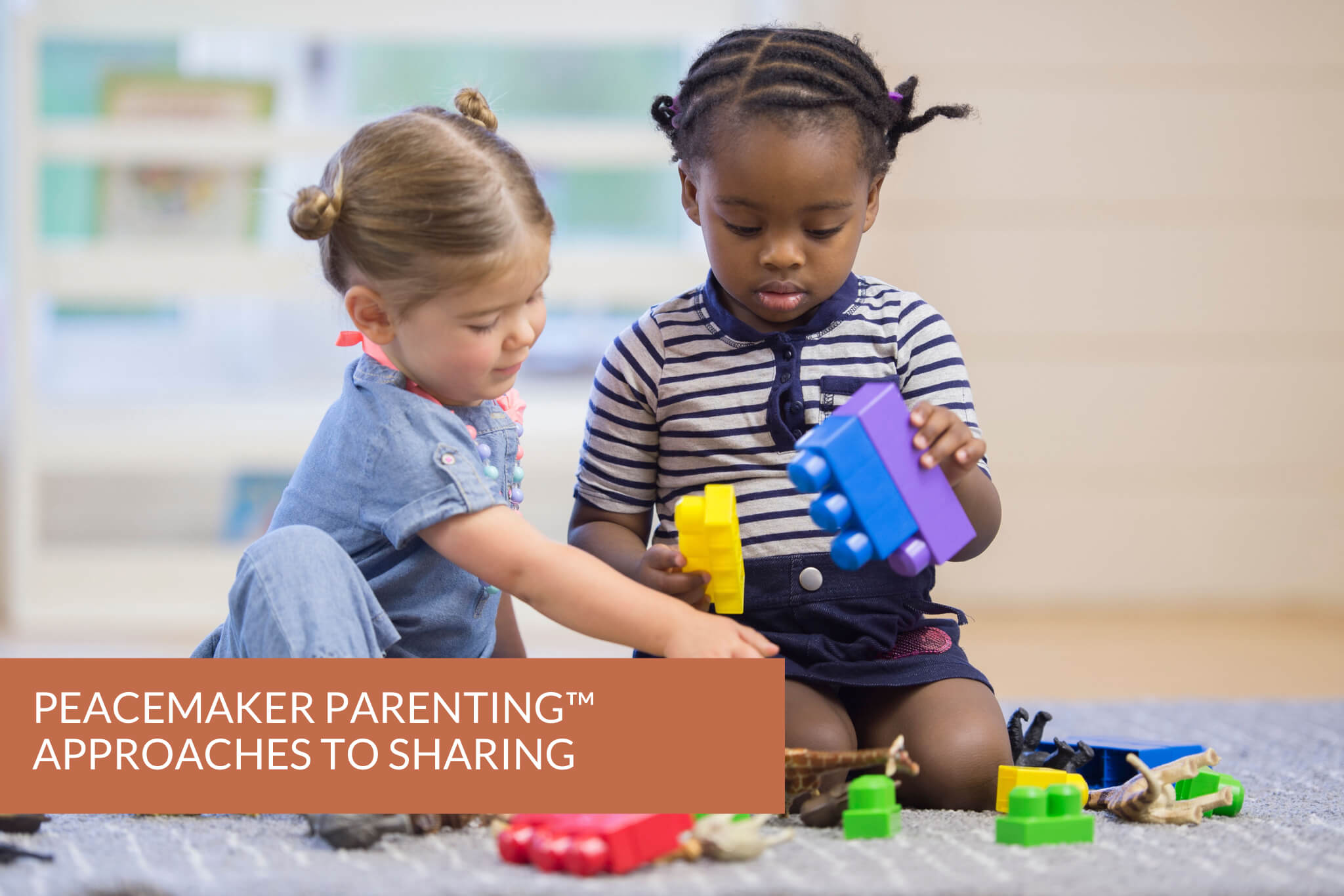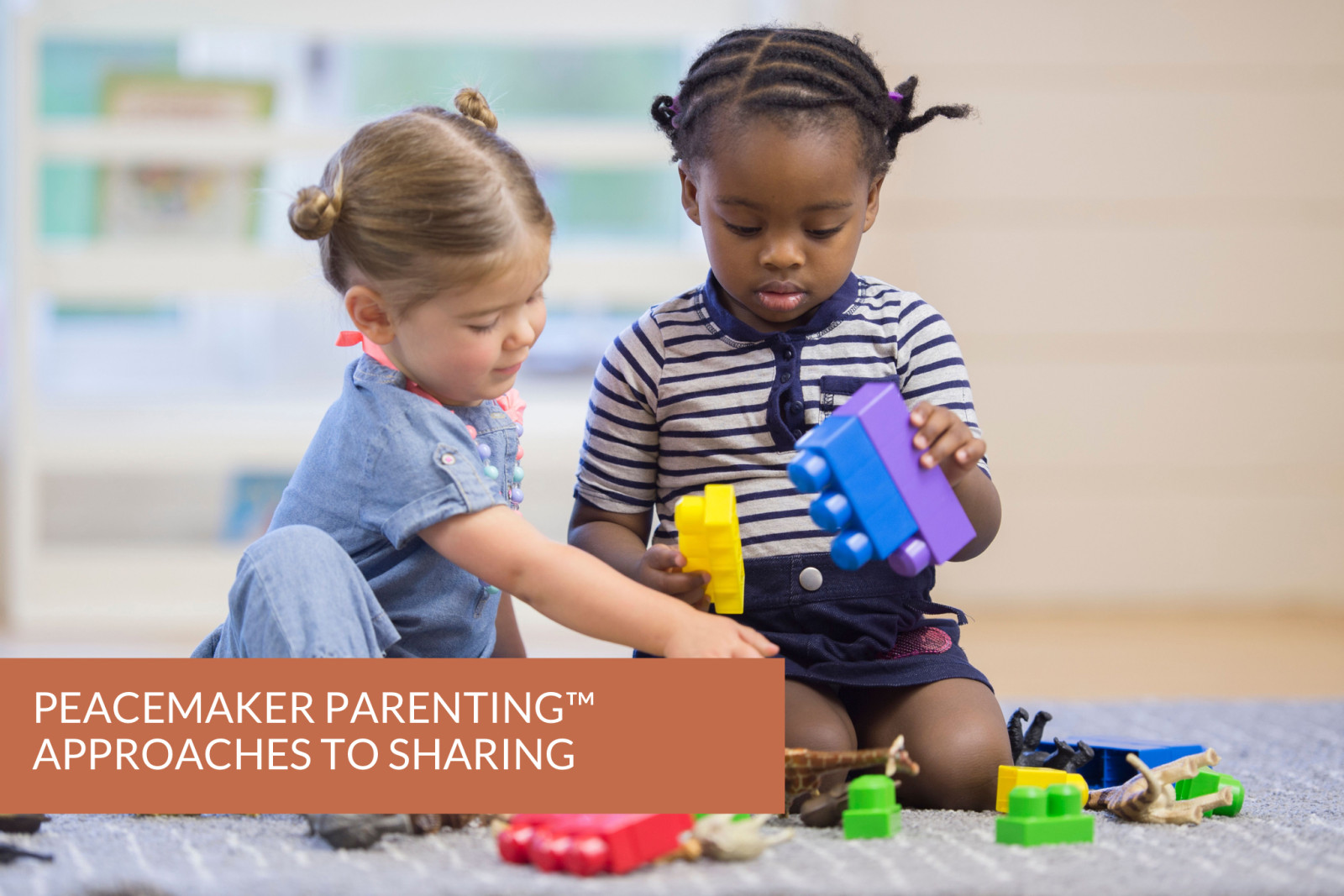
Does Peacemaker Parenting Work for Large Families?
Christian parents often look to authors and social media influencers for inspiration, support, and guidance on their parenting journeys. Many Christian influencers with large families (up to interpretation, but we’ll say four or more children) provide parenting examples that include time outs, spanking, and other punishment/reward systems that seem to work well for them in managing their large broods. If some of these strategies don’t feel right to you–fear not! There is another way that can lead to beautiful, fruitful relationships with your many children–and, yes, a peaceful home with healthy boundaries as well. Let’s dive in!

When it comes to teaching our children to share, parents usually have really great goals, and a few mismatched expectations. Peacemaker Parenting™ can help you align your parenting goals, family values, and reasonable expectations so that you can disciple your children towards generosity of spirit. Let's dive in.

Understanding Scaffolding and How it Helps Kids Learn
Scaffolding, as a parenting tool, draws its metaphor from construction, where temporary structures are erected to support the building process until the structure can stand on its own. In the realm of child development, scaffolding refers to the supportive techniques and guidance provided by parents or caregivers to help children learn new skills or concepts. This strategy emphasizes the importance of providing just enough assistance to enable a child to accomplish a task independently, gradually reducing support as the child gains proficiency. You're already familiar with scaffolding when it comes to teaching children to read. First, you help them learn to recognize letters, then you help them learn the sounds of individual letters, then letter groups, and finally words.
Adaptable Support Strategies
Effective scaffolding involves recognizing a child's current level of understanding or skill and then offering appropriate support to help them progress further. This support can take various forms, such as breaking tasks into manageable steps, offering verbal prompts or cues, providing demonstrations, or offering constructive feedback. Importantly, scaffolding should be flexible and responsive to the child's individual needs, adjusting the level of support as necessary to promote optimal learning and development. Here’s another quick example of scaffolding in action:
Scene: A boy, Alex, sits on the floor struggling to tie his shoelaces.
Dad: (Observing Alex's attempts) Hey, Alex, it looks like you're trying to tie your shoelaces. That's great! Do you want some help?
Alex: (Frustrated) Yes, please!
Dad: Okay, let's break it down. First, make two bunny ears with the laces, like this. (Demonstrates)
Alex: Like this?
Dad: Perfect! Now, cross them over each other and pull one through the hole. Remember?
Alex: Oh, I think I got it! Now I’m going to pull them tight. (Successfully ties shoelaces) I did it!
Dad: Great job, Alex! You're getting the hang of it. Remember, if you ever need help, I'm here.
Meeting Kids Where They Are…
One key aspect of scaffolding is the notion of "zone of proximal development" (ZPD), a concept introduced by psychologist Lev Vygotsky. The ZPD refers to the difference between what a child can do independently and what they can achieve with the support of a more knowledgeable person, such as a parent or teacher. Scaffolding operates within this zone, providing the right amount of assistance to help children advance their skills and understanding.
…So They Can Grow From There!
Through scaffolding, parents not only facilitate their child's learning but also foster independence and confidence. By offering support tailored to the child's abilities and gradually allowing them to take on more responsibility, parents empower their children to tackle challenges with increasing autonomy. Ultimately, scaffolding nurtures a child's development by providing the necessary support structures to help them reach their full potential.
Using Scaffolding to Help Share the Gospel with Children
Scaffolding, as a parenting concept, can be a powerful tool when it comes to sharing the gospel of Jesus with children. Just as in other aspects of child development, scaffolding in this context involves providing supportive guidance tailored to the child's understanding and needs, gradually empowering them to grasp deeper spiritual concepts and develop a personal relationship with Jesus.
Laying the Foundation Through Storytelling
Initially, parents can lay the foundation by introducing children to simple, age-appropriate stories from the Bible that convey key attributes of God and His character. Through storytelling, parents can scaffold understanding by breaking down complex Biblical narratives into digestible segments, emphasizing the trustworthiness of God as the hero of the story, and inviting children to think about how these stories relate to their own lives.
Initially, parents can lay the foundation by introducing children to simple, age-appropriate stories from the Bible that convey key attributes of God and His character. Through storytelling, parents can scaffold understanding by breaking down complex Biblical narratives into digestible segments, emphasizing the trustworthiness of God as the hero of the story, and inviting children to think about how these stories relate to their own lives.
Engaging in Meaningful Discussions
As children grow and mature, parents can scaffold their spiritual development by engaging them in meaningful discussions about faith and what it means to follow Jesus. This might involve asking open-ended questions to encourage critical thinking, such as "Where did you see God at work today?" or "What do you think Jesus would do in this situation?" or "How can we show love and kindness to others, just as Jesus did?" By prompting children to reflect on their beliefs and values, parents can help them internalize the principles of their faith and apply them to their daily lives.
As children grow and mature, parents can scaffold their spiritual development by engaging them in meaningful discussions about faith and what it means to follow Jesus. This might involve asking open-ended questions to encourage critical thinking, such as "Where did you see God at work today?" or "What do you think Jesus would do in this situation?" or "How can we show love and kindness to others, just as Jesus did?" By prompting children to reflect on their beliefs and values, parents can help them internalize the principles of their faith and apply them to their daily lives.
Providing Experiential Learning Opportunities
Most Christian parents are already scaffolding their children's understanding of the Gospel by providing opportunities for experiential learning and participation in faith practices and rituals. Attending church services together, participating in prayer and worship, and engaging in acts of service and outreach as a family are all ways you can help your children learn what it means to live as a follower of Jesus, deepen their connection to their faith community, and develop a sense of belonging within the larger body of Christ.
Most Christian parents are already scaffolding their children's understanding of the Gospel by providing opportunities for experiential learning and participation in faith practices and rituals. Attending church services together, participating in prayer and worship, and engaging in acts of service and outreach as a family are all ways you can help your children learn what it means to live as a follower of Jesus, deepen their connection to their faith community, and develop a sense of belonging within the larger body of Christ.
Ultimately, the goal of scaffolding in sharing the Gospel with children is to nurture a foundation of faith that centers God as wholly trustowrthy. By providing structured guidance, meaningful engagement, and opportunities for personal reflection and growth, parents can start planting the seeds of a deeply-rooted, robust relationship with Jesus.

In the journey of parenting, finding harmony often feels like seeking an oasis in a desert. It's a quest for balance amid chaos, understanding in the face of conflict, and empathy within every interaction. The essence of parenting in harmony is not about achieving a perfect balance but learning and practicing skills that foster a peaceful and nurturing environment for both parents and children. Here are practical tips and healthy conflict resolution skills to guide you toward finding harmony.
Cultivate Open Communication
Open, honest communication serves as the cornerstone of understanding and resolving conflicts. Encourage an environment where both husband and wife feels comfortable and safe expressing their thoughts, feelings, and concerns without fear of judgment. Practice active listening, which involves giving your full attention to the speaker, acknowledging their perspective, and responding thoughtfully, not to change their mind, but to better understand their perspective.
Practice Empathy
In John 11 we read about the death of Lazarus. Shortly after he died, his sisters, Martha and Mary, overcome with grief, start blaming Jesus for Lazarus' death. What's surprising to note is that their emotional responses aren't actually rooted in reality. "Lord, if You had been here, our brother would not have died!" they both lament to Jesus.
He had every right to correct their misunderstanding of reality. He knew that Lazarus' death was necessary to demonstrate His divine power. He could have said something along the lines of "Feelings aren't facts" or even offered some kind of authoritative expectation to trust Him. Instead, John 11:33-35 describe Jesus' deeply empathetic and compassionate response. He is deeply troubled and weeps with them. This is empathy.
Empathy bridges gaps between differing viewpoints. It allows you to see the world from your partner's and child's perspective. This doesn't mean you have to agree with them but understanding their feelings and where they're coming from can significantly diffuse tension and lead to solutions that work for everyone.
Be Intentional about Mutually-Respectful Dialogue
Romans 12: 10 exerts us, "Be tenderly devoted to one another in brotherly love. Out-do one another in giving honor." If this is Christ's expectation for His church, how much more tender, honoring, and life-giving should our homes and families be?
Non-violent communication is an approach to communication that focuses on compassion, empathy, understanding, and honor. It is not meant to end all disagreements or avoid conflict, but rather, it is a way of communicating that cultivates peace in the midst of conflict. One of the goals of non-violent communication is to practice respecting yourself and others while discussing difficult topics and navigating conflict and disagreement. It minimizes judgemental statements that place shame and blame on others, and replaces it with communicating personal needs and boundaries with honor and respect.
Collaboration a journey, not a destination. It is a habit and a rhythm of your home and marriage, not an end goal. It is an intentional path you and your spouse walk together, not the pinnacle of your wanderings.
There are six steps to keep keep you and your partner on the path of collaboration. Each one serves an important purpose, and most of the time it will serve you best to walk this path in order:
- Regulate - make sure you're both calm and able to listen well, reason well, and love well
- Express Needs/Concerns
- Look for Common Ground - where do you already agree?
- Suggest solutions or plans for specific parenting challenges
- Agree on a Plan - you're both committed to giving this a try (a minimum of 4 weeks should be considered, as it takes time to develop new habits and see growth!
- Assess the Plan at a designated time - evaluate how well the solution or plan is working, and what may need to be done differently
Taking time to show honor, respect, concern, and care for each other's needs and feelings will help cultivate harmony in your parenting, even when there isn't absolute unity.
Seek Support When Needed
Remember, it's okay to ask for help. Whether it's consulting with a family therapist, joining a parenting group, pursuing parent coaching, or simply reaching out to friends and family for advice, external support can offer new perspectives and strategies for finding balance and harmony in your parenting journey.
Harmony in parenting is an ongoing process of learning, understanding, and adapting. By fostering open communication, teaching conflict resolution skills, and incorporating calming practices like the use of essential oils, you can create an environment where all family members feel seen, heard, and valued. Remember, the quest for harmony is not about perfection but about building a foundation of love, respect, and mutual support.
Are you struggling to find harmony and unity in your parenting approach? Our workshop, Peacemaker Parenting when Parents Disagree is designed to help you navigate challenging discussions, find common ground, and forge a path forward in your parenting with more peace and harmony.


It’s not enough to know what not to do. We need to know what we are going to do when we’re running low in both the caffeine and patience departments. When we are in the days of going from child to child through the night, waking up early, swimming in mismatched socks and burning breakfast again, it can be hard to remember what we're "supposed" to do! Here are a few ideas you can practice to find out if it works well for your family:
First, stay calm
Keep your voice and your body calm. You are your child's mentor, guide, and most trusted influence. You do not prove that you're in charge by controlling your child, you prove you're in charge by controlling yourself. You may need to use your calm body to help them.
Example: Your child does not want to brush their teeth. Rather than continuing to say "you have to brush your teeth" in a thousand different ways, or making threats to try and convince them to do the thing, it might just take you gently helping them walk into the bathroom. And as you walk, say, "You don't want to brush your teeth right now. It is my job to help your teeth grow healthy and strong so we are going to brush your teeth together, I will help you. (We have more tips for teeth brushing here.)
Second, be compassionate
If you struggle to empathize with your child, try to think about how you feel when someone else exerts their will, authority, or agenda on
you. Chances are, you feel some discomfort. Hold boundaries and limits with compassion and empathy. Try to get to the heart of the issue by being curious about what's happening under the surface. For older children you can ask them, "Hey, I noticed ______________‚ what's up?" For younger children, you can validate their feelings while holding your boundary, "You are very sad it is time to leave the park. I understand, I feel sad when I have to leave my friends too."
Third, be clear
Peacemaker Parenting values teamwork and collaboration, and boundaries are primarily enforced to keep people, animals, and things safe and healthy. Being calm, compassionate, and clear about boundaries is kind, because it establishes a culture of safety and security. Calmly and clearly describe how you are going to help them or hold a boundary: "It is not safe to jump on the couch. I am going to take you outside so you can jump on the trampoline." For older children, you can offer a do-over.
Fourth, be co-regulating
You do not need to "fix" your child's feelings about your boundary. It is okay if they're disappointed, confused, overwhelmed, disoriented, upset, sad, and annoyed. Those are normal human emotions and your child will experience them thousands of times throughout their life. When you are not overwhelmed by your child's feelings, they will learn not to be overwhelmed by their feelings! Rather than shutting down their emotional reaction, be the non-anxious presence that they need. Your calm nervous system quite literally teaches their nervous system how to return to a state of calm (over many years and with lots of practice!).
Lastly, rely on wisdom, not rules when it comes to holding boundaries
As parents it is important for us to recognize when we've drawn a boundary unnecessarily, unreasonably, uncharitably, or without proper perspective. It is okay reconsider and change your mind - this models flexibility, humility, collaboration, and learning from mistakes. This requires wisdom, discernment, attunement to your child's physical, emotional, and sensory needs, self-awareness, and emotional maturity. It is a learning process, and that's okay.











